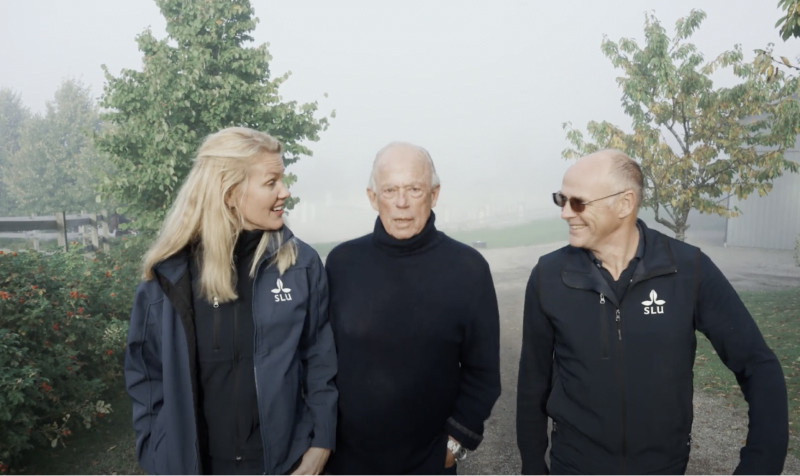
15 January 2024
The well-known professor at SLU (Uppsala) holds the title of Professor at the Department of Anatomy, Physiology and Biochemistry but he also juggles consulting, lecturing, writing, and researching commitments on his agenda. And if that’s not enough, his expertise in biomechanics and sport science make him in demand on the world stage of equestrianism – not in the vet hospital, not in the judges’ booth, and not out on course, but at ground level.
Ground level? Since 2010, the Swedish professor has served the governing body of the horse world, the Fédération Equestre Internationale (FEI or International Federation for Equestrian Sports) at more than 50 high-level events. He is a member of the FEI Veterinary Committee who plays an additional and uniquely specialized role: he is responsible for testing arena footing quality at events that have included the Olympics Games equestrian events in London, Rio de Janeiro, and Tokyo, as well as at FEI international and regional championships and 5* events worldwide.
His role also makes him a unique unofficial “roving ambassador” for Sleip as he travels the world to these events, but he speaks about Sleip from direct experience. He has amassed an impressive bank of Sleip data, with more than 1000 registrations for his research horses alone, all collected since September 2021.
While Lars Roepstorff may utilize Sleip within his own precise research protocols, his interactions with veterinary professionals worldwide give him a unique viewpoint on some of the ways that Sleip could be – and no doubt will be, according to him – used at the highest level of equestrian sports.
“My work is measuring the surfaces at big equestrian events. Recently I worked at the Asian Games at Hangzhou in China for almost three weeks. And I was showing Sleip to people. All of them–whether my veterinary colleagues or the top riders–were thrilled when they saw the Sleip stuff. Every one of them had an immediate use for it. They appreciate the versatility. Sure, it is a quantum leap of technology but they are impressed by the ease of use. To just get out your phone and manage to follow and track the horse with such good videos? Just that part alone is amazing!”

Rather than think about Sleip on a case by case basis as veterinarians would have always done in the past, Lars Roepstorff conceives Sleip as a time-based tool for practicing vets. A current injury is part of a continuum of care and oversight provided over months or years, he says, and Sleip can make time speak, by making it so easy to compare where a horse was a week ago, a month ago, or a year ago. Or longer! Where it is today is part of a larger continuum of time-based data belonging to that horse.

The challenge is when you start understanding objective gait analysis. (I don’t like to call it a lameness examination, because lameness makes you think of pain) You measure asymmetry. It has many causes – everything from pain, old injuries, the horse’s natural laterality. Even the trainer and the rider can play a role. And, yes, whatever else you do with the horse. Remember, we humans are by nature more asymmetric than horses. And so, our interaction will naturally induce asymmetry in the horse. If you are not used to doing locomotion analysis objectively you might be worried to see asymmetry in your horse. But it doesn’t need to be identified as “lameness”. There could be another reason.
One unique aspect of the Sleip system is that it will elevate discourse about the role of symmetry in the athletic horse, and what degree of asymmetry is acceptable. Lars Roepstorff is happy to discuss the concept of symmetry in the horse, as well as the meaning and effect of asymmetry:
“All things in nature, whether plants or humans, are asymmetric,” he began. “It is important for us to discuss whether we need perfect symmetry in a horse. The answer is ‘no’, but yet we always talk about ‘straightening’ the horse’s movement, and the need for the horse to be able to do lateral movements equally good on either rein. What it really is, is a quest for a balance: so how much symmetry do we want? Or need?
“It is interesting to follow horses that are born with laterality,” he continued. “As you start working with them, you can evaluate it. Training can improve that natural asymmetry to a certain extent and you can follow that change in a young horse with the Sleip app.”
Once in a horse’s data file, that early asymmetry in a young horse can be a reference point, using Sleip.
Think about this for a minute: Continuous monitoring of a horse. The vet may say that the asymmetry is very subtle or that it is about the training or about laterality. Then it becomes very important to continue to monitor that asymmetry and see how it changes. With Sleip, you can detect early changes in horse locomotion. The app can tell you that there might be an issue.
One of the most appealing aspects of the Sleip system is its accountability. Sleip was developed through careful validation. The app’s results were compared with parallel results from the gold standard, the high speed camera system used in research at centers like Uppsala. “When I have a research question, I will always go to the high speed system,” Lars Roepstorff said. “But these marker-based systems are expensive and cumbersome to use.”

Expensive and cumbersome, but necessary, in Lars Roepstorff’s world where errors and inconsistencies can foul an entire research project or compromise a data set being tracked. “The high speed system is necessary to create these kinds of apps, like Sleip, and also to compare them. Few of the apps for sale today have a good science-based validation and that is one of the very good and valuable things about the Sleip app.”
“My interest is in surveillance. Of course Sleip is mainly marketed and applied as an aid to vets but I think it is really really interesting to think of it as a surveillance tool that could be used by every horse owner (in the future, of course). There are many examples. One might be the longer rehabilitation for a horse with a tendon injury. It is really important and useful to monitor the recovery over time. Horses are not the same. I prefer monitoring at weekly intervals.
“But look to the future. Sometimes a horse is sore, maybe because it is freshly shod or has a slight sprain, or another simple injury. You won’t need to call the vet. Just stay calm and if you have the app, you can monitor it. You can even monitor on a daily basis, if you want to, and see how the asymmetry wears off. I foresee this is something that is going to be used proactively by horse owners in the future.”
While Lars Roepstorff has no direct role in the Sleip corporate system, he is what you could call a friend of the family. Sleip was developed in part by one of his former doctoral candidates, Elin Hernlund and his son, Christoffer, has been hired as a biomechanics researcher in the Sleip team. Lars Roepstorff has used the system extensively and makes his comments from his own experience with the app.
Wherever motion analysis is headed, Lars Roepstorff will always be one of the first to know—and get there. He has embraced Sleip as a unique and versatile and forward-pointing tool, one that is opening doors for veterinarians around the world to embrace progress and add their ideas and experience to the exciting future of Sleip. See you there.

Professor at the Department of Anatomy,
Physiology and Biochemistry (AFB); Division of Anatomy and Physiology, Swedish University of Agricultural Sciences